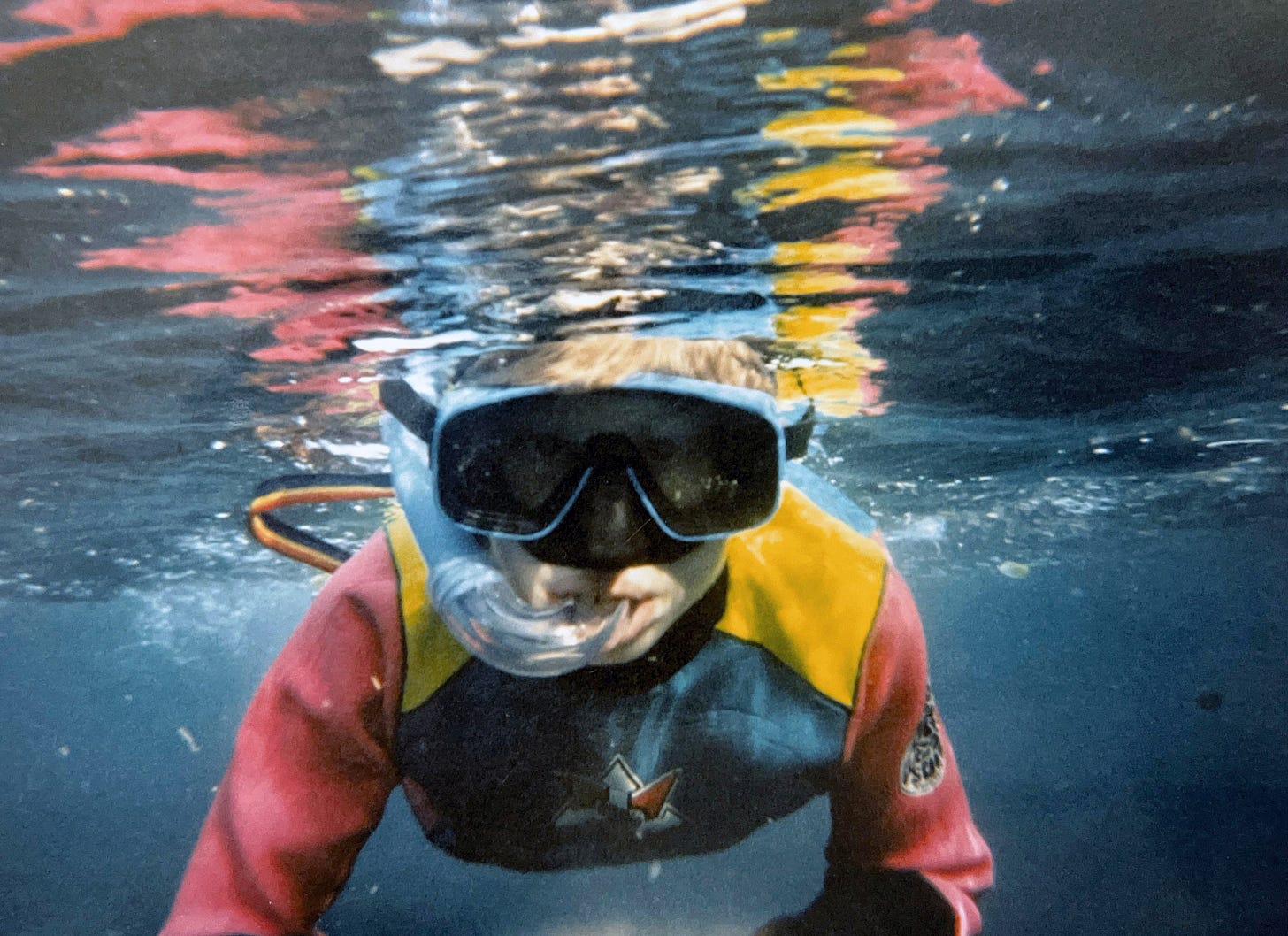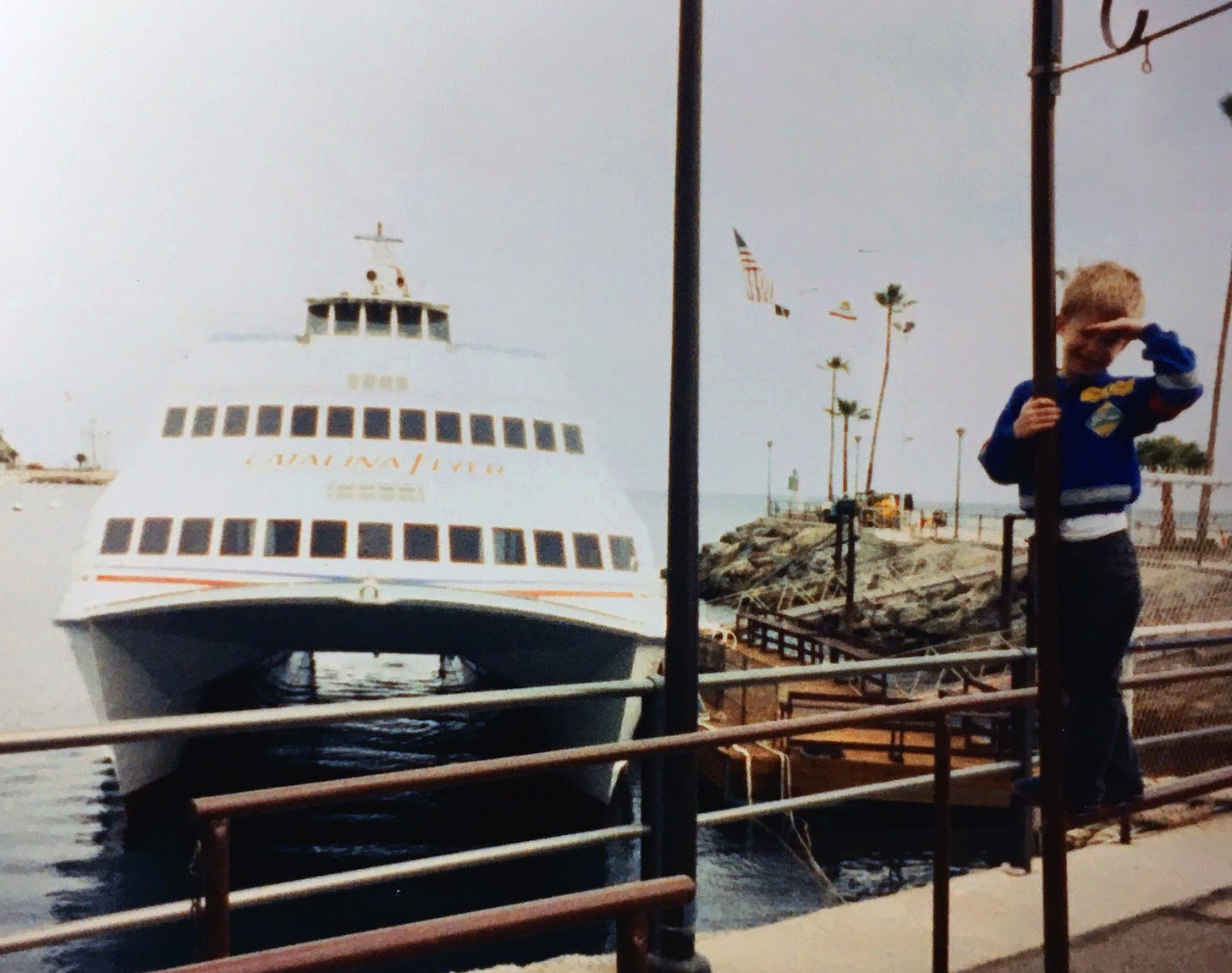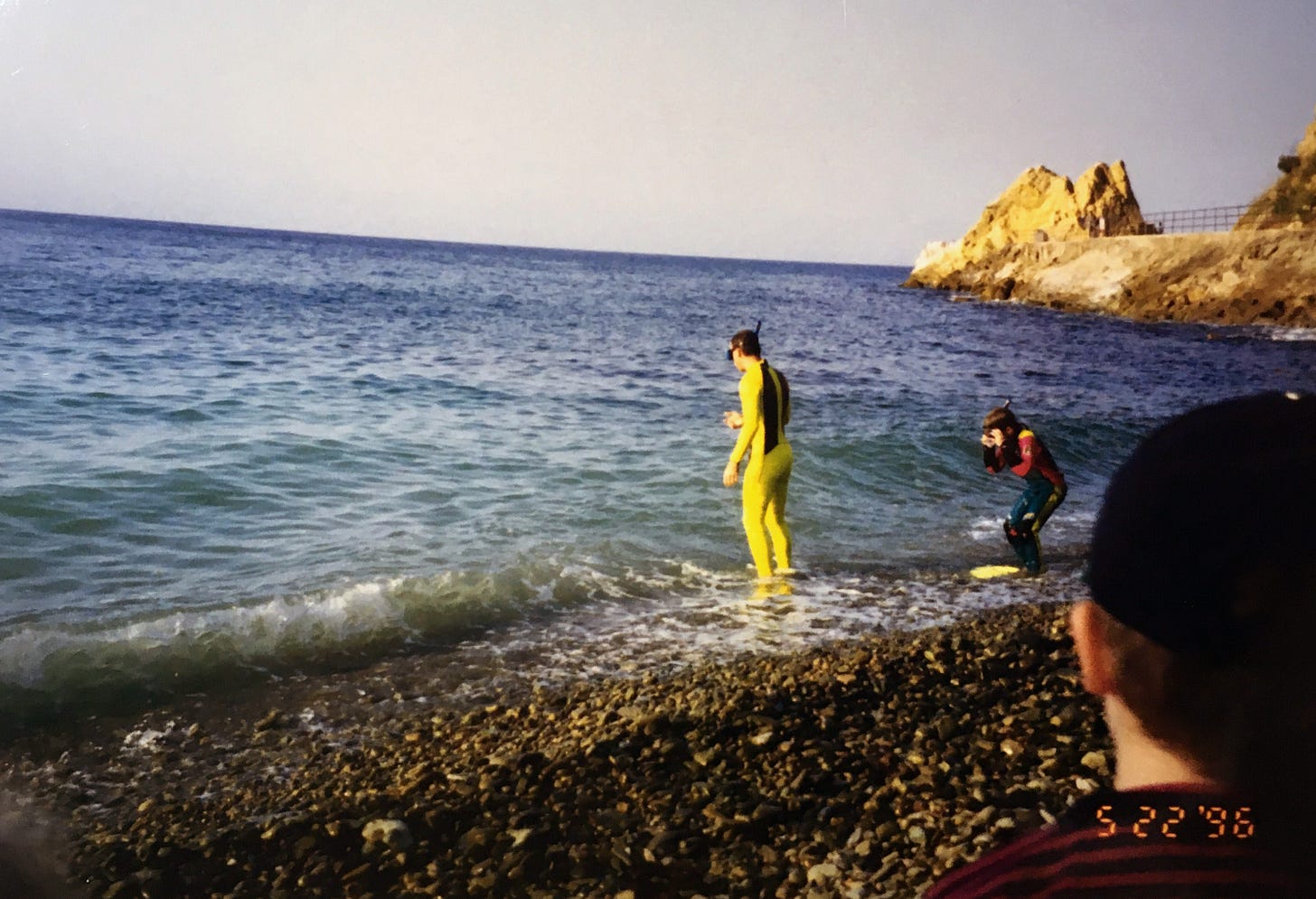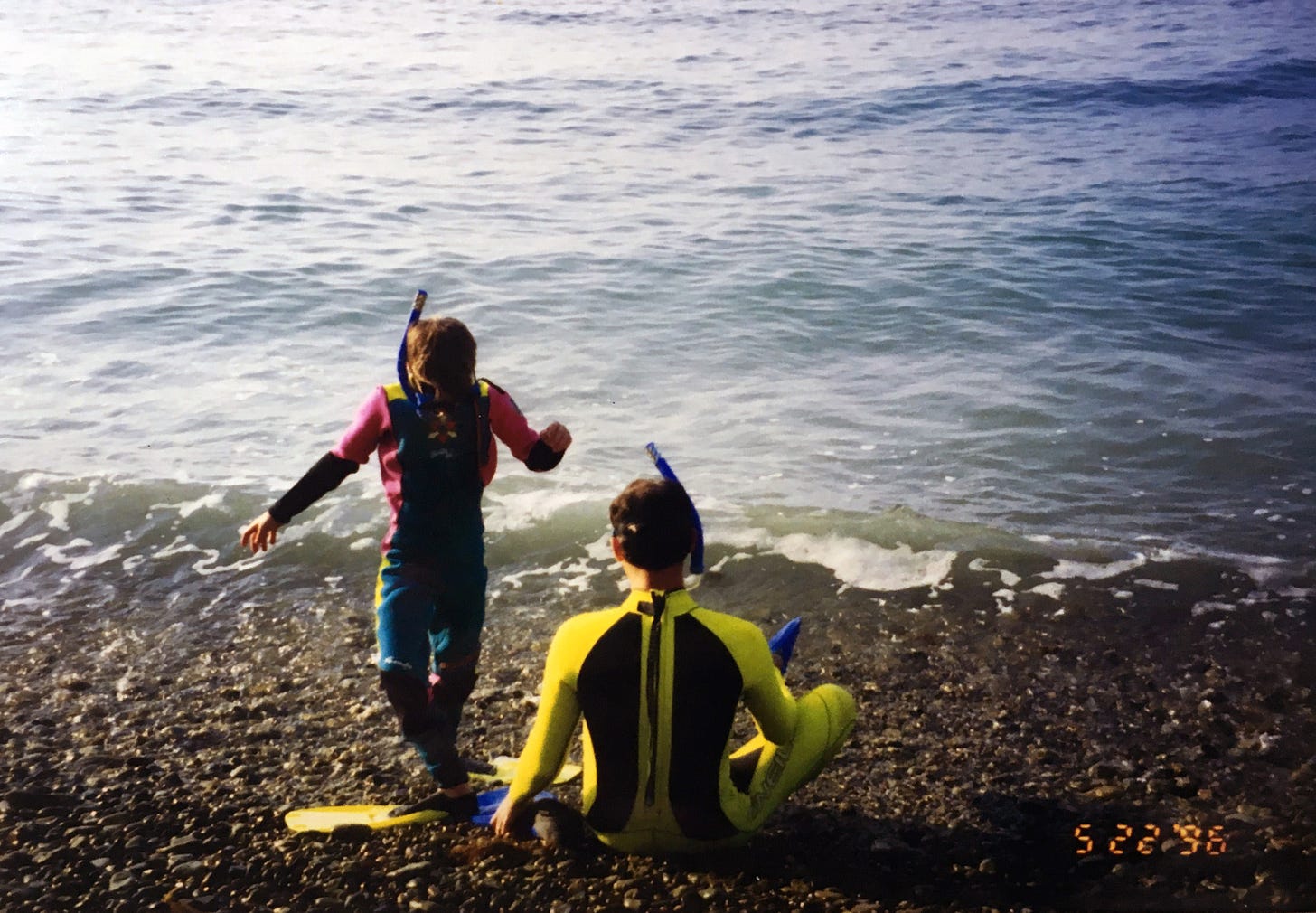Try Snorkeling: The Gateway Drug to Scuba Diving
Scuba diving is the greatest outdoor activity ever invented. For some people, it’s terrifying, but fear not: if you can’t handle its full potency, try scuba’s little brother: snorkeling!
One of the greatest things about my childhood was the way our family had a sense of discovery and exploration. And I’ve kept that with me for the rest of my life.
When I was growing up, we took more than one weekend family trip to Santa Catalina Island (or, as people call it, simply “Catalina”), one of the Channel Islands right off the coast of California next to Los Angeles.
We lived in Stockton, and our huge family of 9 people never quite had the money to fly everyone out to Hawaii, but we could take a road trip a few hours down the interstate to Long Beach or Newport Beach, hop on a Catamaran and find ourselves on the closest “tropical” island we could find all in the span of about a day.
(Side note: you really can call Catalina a “poor man’s Hawaii” since it’s so close to Los Angeles, it’s FAR less expensive, and you don’t even need to fly there. It’s hugely underrated).
In Avalon (the main city in Catalina), we would go to the beach and make sandcastles, eat fish tacos, and sometimes, take a trip out on the water on a glass-bottomed boat so we could see the fish, coral, and anemones below us.
Once, we took a “flying fish voyage” at night where our boat flew through the water in the dark at high speed and shined giant spotlights into the deep, which apparently had such a mesmerizing effect on the nearby flying fish that they jumped out of the water and sailed right over our heads, sometimes even landing on the boat deck with a “thump” sound.
All of that was totally wild. I was completely enraptured with it: the water, the bioluminescent phytoplankton that lit up when the surf was agitated, the silver flying fish that looked more like birds or airplanes than actual swimming creatures, and the extremely orange-colored Garibaldi fish that littered the coastline across the entire island.
But I never really went in the water in a big way. That was until my parents offered to take me snorkeling.
I loved the idea of going deep to see the wildlife, but it was all very scary. Just jumping into the water and going way out into the big ocean and hoping to see some fish, wearing a wetsuit but otherwise remaining completely unprotected? What a crazy idea!
On a trip to Catalina we took when I was 11, I decided I was ready to try it. So, on our way there, we went to a dive shop and bought a super-old wetsuit that—even though it was very flamboyantly colored, which I found embarrassing—fit me just right.
We got the rest of the requisite gear: snorkel, mask, and flippers, and hit the road. When we arrived on the island and got all settled in, we ventured out to a seemingly random location where my parents promised me it was okay to go snorkeling.
You have to picture it: we drove out to the middle of nowhere, found a teeny, tiny parking spot on the side of the road, and my mom basically looked at a map and pointed to a rocky section on the beach and announced in a Piratey voice that this was the spot.
“Ahoy, see rocky point over yonder? There be Lover’s Cove!”
…or, that’s how I remember it, anyway.
“Is this even legal?” I wondered.
It boggled my mind to think that my parents were saying we would just step out of our car parked on the side of the highway, put on our gear, waddle awkwardly toward the water, and… jump in and start snorkeling.
But that’s exactly what we did.
AND IT WAS AMAZING!!!
I kid you not: this experience as an 11-year-old boy absolutely changed my life forever.
Skip ahead a few years, and I ended up getting my PADI Open-Water Diver certification with my dad and younger brother, and on our next trip to Catalina Island, we all went diving together.
At the tender young age of 14 years old, I was out in the open water of the Pacific Ocean, doing the greatest thing people have ever done in the history of mankind. But scuba diving is a topic for another time: here, I’m only talking about snorkeling.
I’ve been an Open Water diver now for over 24 years. That’s totally nuts. I can’t even believe that. But here’s the thing: many times, I’ll talk to people about scuba diving, and they’ll say things that reveal so many fears of going under the water, and I totally get that.
They’ll say, “I would love to try scuba diving BUT…” then give a long list of potential objections:
I’m claustrophobic, and I can’t imagine breathing through a tube.
I’m terrified of deep water.
I feel like I would panic once I got to the bottom.
I’m afraid of sharks.
I’m a bad swimmer.
I have vertigo / I have asthma.
I have problems equalizing my ear pressure.
I would choke on a “mouthpiece” like that.
These are all perfectly reasonable objections, and I completely understand why someone would be afraid of scuba diving if these were all true.
Now, most of these aren’t actually real reasons to avoid becoming an Open Water Diver, and I could refute almost all of them. But that’s beside the point.
I never tell people, “Those aren’t legitimate concerns,” or “That’s no big deal, just get over it.”
Instead, I say: “That’s okay. Why not try snorkeling instead?”

Snorkeling is an extremely low-pressure, low-risk, entry point for going into the water. It requires no specialized gear, no compressed air, and no certification or classroom time.
Seriously, you just get in the water and go!
If you’ve ever thought about scuba diving and you’ve been too afraid to give it a shot, here are a few things about snorkeling you should know, and I hope I can convince you to give it a try.
#1) Fear: “I’m terrified of deep water.” Fact: You don’t need to go deep.
People get confused about this sometimes. They think you need to go “deep” into the water to see the wildlife or that you need to take a boat WAY out far from the shore in the blue ocean away from land.
This is almost never true. Truly “deep water” has very little for you to see anyway. The wildlife you actually want to see is in relatively shallow reefs not so far from the shore.
In a weird way, I would imagine it’s something like taking a rocket to the moon and punching through Earth’s atmosphere — “outer space” is actually only 62 miles from land. It’s probably a lot closer than you think.
The same is true when scuba diving, and also with snorkeling. When we were at Lover’s Cove that very first time I ever tried snorkeling, I jumped in the water with my dad, and held his hand.
I was initially disgusted as we started kicking away from the beach: all I saw was muddy, swirly, brown sand and ugly, dark, dirty water with very little visibility. I was extremely disappointed.
But after a few minutes, we penetrated some sort of natural barrier, and BOOM: there it was! The water instantly became clear, and there were coral and fish and seaweed and sponges EVERYWHERE. It was an astonishing transition; I could barely believe it. You simply cannot understand this by just standing on the shore and looking out at people snorkeling.
You’ll think, “Wow, they’re not so far out—I can just see them right there. What could they possibly be looking at?”
But you’d be wrong: there’s a transitional point where, not so far from the beach, everything comes into view immediately, where the water instantly gets colder, and it becomes clear, and you enter an otherworldly dimension full of the most mystifyingly beautiful marine life you’ve ever seen.
Yet, if my dad and I had just stopped for a moment and popped our heads above the surface to tread water, we could have easily seen our car parked on the side of the road from where we were.
I just can’t explain this in a way that you can understand until you try it. Suffice it to say: there’s a whole world out there, and it’s just barely outside of your reach, but if you put on a mask, fins, and snorkel, you can get there within minutes.
The best part about all this is that you can always dive deeper to explore further if you want. Just hold your breath, close off the air in your snorkel, and pop down for a bit.
Search around for whatever wildlife you want to see, then pop right back up, clear your snorkel with a big burst of air, and resume floating on the surface.
It’s the best of both worlds: if you have a properly weighted dive belt so you’re neutrally buoyant, you can go as deep as you want and stay down as long as you can hold your breath.
Or not. It’s all up to you. Do what you feel comfortable with.
#2) Fear: I’m not a good swimmer. Fact: you don’t have to be—you aren’t even “swimming,” really.
People get confused about this all the time.
First of all, if you’re in salt water, like in the Pacific Ocean, where Catalina is, your body is going to float more than it would in, say, a lake or a swimming pool.
Second of all, if you’re wearing a wetsuit, you’re going to be even more buoyant, to the point where you’ll need a weight belt just to bring you back down to neutral.
You won’t sink. Really, trust me. That’s not a thing.
Third of all, you aren’t actually “swimming” in the traditional sense. You will have GIANT fins (or “flippers” as some people call them) on your feet, and you will be amazed at the power they have to propel you far distances easily.
Can you at least kick your feet? Great, you’ll be fine. (You know the term “go with the flow” was literally invented for this context, right?)
Also, to a large extent, you just go where the current takes you. Exploring the underwater world requires passive observation. You don’t force the ocean to bend to your will; that’s impossibly exhausting. You simply follow where it leads.
When you first leave the beach to go deeper, sure, you have to fight the waves a bit, but it’s not that hard. And yes, you definitely want to pace yourself and reserve strength for when you’re ready to head back.
But snorkeling is not an extreme sport: you’re not going that far out in the first place—you don’t need to.
You just go out as far as you need to find the wildlife you want to see, let the waves carry you where they may, and enjoy the ride. When you’re done, head back. It’s that simple.
#3) Fear: I can’t afford it/I’m not certified/I’ve never been trained. Fact: you don’t need any of that.
Scuba diving is a complicated, potentially dangerous activity involving compressed air, nitrogen absorption into the bloodstream, hard math requiring safety stops, carefully calculated “bottom time” and surface intervals, and a lot more.
You can’t dive too many times in a row, and you can’t fly on an airplane within a certain window of your last dive, or, as I said, you could die.
There’s a reason why scuba diving requires classroom instruction, closed water dives in swimming pools with the close supervision of a diving instructor, and more. If you’re not careful, the results could be fatal.
But snorkeling has none of that. Just toss a wetsuit, some fins, and a mask in your car trunk, park on the side of the road by the beach, and go out and see what you can see.
Seriously, it is just that simple.
#4: Fear: It’s an expensive hobby, and I can’t afford it. Fact: Snorkeling is literally free.
Scuba diving is expensive, I’ll give you that. You have to get your certification first, take refresher courses every few years, find a dive shop when you want to go diving, buy incredibly expensive gear or rent gear, go out on a boat, tip the captain and crew, etc. It’s a whole ordeal.
All in, it’s probably going to cost you at least $1,000 to get your first dive in, factoring in your training and certification, your first dive, gear, drive time, gas, flights, hotels, etc.
But as I said before, snorkeling is free.
Just buy a wetsuit (the one we got for me was used and cost probably less than $50), plus a fin, mask, and snorkel set (which might cost you another $50).
That’s it. For $100, you’re now a snorkeling pro.
Add in a swimsuit that you surely already own, and you’re good to go. Like, for the rest of your life. You’re done. You have all the gear you’ll ever need now.
If you want to spend more, you can, but that’s only if you choose to because you want to get fancy. You certainly don’t need to.
So, in conclusion, what are you waiting for?
To misquote John Muir: “The water is calling, and I must go.”
Come with me, will you?
Get a $100 set of snorkeling gear, and stop making excuses.
Remember, if you like the gateway drug of snorkeling, you can always do harder stuff: scuba diving will always be there. But start small and get hooked on the readily available and affordable drug of choice.
Then, you can increase your dosage and spend more on the ultimate thrill: going 60 feet under for an hour at a time. That’s a wild adventure… but you can build to that.






